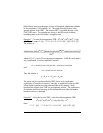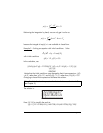
Page 16-13
Θ Differentiation theorem for the n-th derivative.
Let f
(k)
o
= d
k
f/dx
k
|
t = 0
, and f
o
= f(0), then
L{d
n
f/dt
n
} = s
n
⋅F(s) – s
n-1
⋅f
o
−…– s⋅f
(n-2)
o
– f
(n-1)
o
.
Θ Linearity theorem
. L{af(t)+bg(t)} = a⋅L{f(t)} + b⋅L{g(t)}.
Θ Differentiation theorem for the image function
. Let F(s) = L{f(t)}, then d
n
F/
ds
n
= L{(-t)
n
⋅f(t)}.
Θ Integration theorem
. Let F(s) = L{f(t)}, then
Θ Convolution theorem
. Let F(s) = L{f(t)} and G(s) = L{g(t)}, then
Example 2
– As a follow up to Example 1, the acceleration a(t) is defined as
a(t) = d
2
r/dt
2
. If the initial velocity is v
o
= v(0) = dr/dt|
t=0
, then the Laplace
transform of the acceleration can be written as:
A(s) = L{a(t)} = L{d
2
r/dt
2
}= s
2
⋅R(s) - s⋅r
o
– v
o
.
Example 3
– Let f(t) = e
–at
, using the calculator with ‘EXP(-a*X)’ ` LAP, you
get ‘1/(X+a)’, or F(s) = 1/(s+a). The third derivative of this expression can be
calculated by using:
‘X’ `‚¿ ‘X’ `‚¿ ‘X’ `‚¿μ
The result is
‘-6/(X^4+4*a*X^3+6*a^2*X^2+4*a^3*X+a^4)’, or
d
3
F/ds
3
= -6/(s
4
+4⋅a⋅s
3
+6⋅a
2
⋅s
2
+4⋅a
3
⋅s+a
4
).
Now, use ‘(-X)^3*EXP(-a*X)’ ` LAP μ. The result is exactly the same.
{}
).(
1
)(
0
sF
s
duuf
t
⋅=
∫
L


















